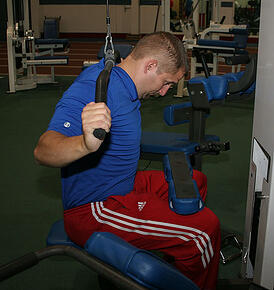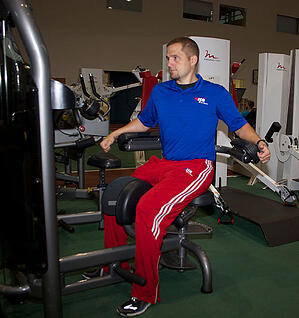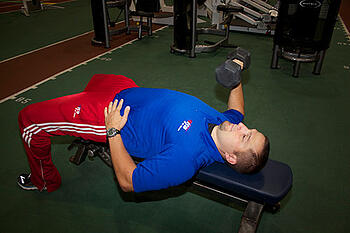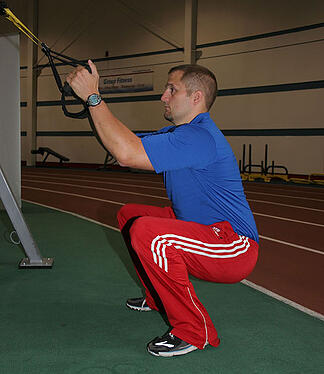Salutations NIFS blog followers! Today’s blog is part 3 of our blog series, “10 Better Ways to Do 10 Exercises.” In the preceding two installments, we took a look at bettering your pushups, helping your squats, and building better pull-downs, in an attempt to help you understand that there may be a better, safer way to exercise and that NIFS is happy to facilitate your fitness experience with these injury-prevention tips.
Now, here are the final three improved exercises.
8. Weighted Sit-ups on an Incline Board
We’ve all seen the famous boxing workout montage and its famous weighted sit-up scene. It must be legit, right? Well, to be honest, the sit-up isn’t exactly the best exercise for your spine. Again, like the torso rotation machine in part 2, we find flexion on a loaded spine to be a loaded gun that could spark any number of injuries.
A good, challenging alternative would be a dead bug on a BOSU balance ball. With your body positioned on the BOSU ball so that you are completely balanced on your back, hold your position (like a plank) without arms or feet touching the ground. To modify the exercise, tap one heel to the ground to regain balance. Start with a 30-second period and progress in time as you become more proficient.


9. Rotating Shoulder Shrugs
The shoulder typically gets a lot of workload, especially when you think about its role in so many exercises. Shrugs, though, are a classic bodybuilding movement and have their place among those who are trying to sculpt their bodies. The main problem lies with the impingement in the shoulder while performing a rotating shoulder shrug.
You can alleviate the need for a shoulder shrug by taking it out of your routine altogether and focusing more on overhead dumbbell press (which works the shoulders as well as the traps). For those who still want to do a shrug, I suggest making the movement simpler by shrugging only up and down.


10. Kip Pull-ups
Kip pull-ups can be considered an exercise that teeters on the edge of dangerous. The exercise itself, if done properly, can be seen as a tool for individuals seeking to increase stamina in the upper body when there is a lack of strength to perform standard pull-ups. By using momentum, an individual is able to “swing” themselves into a pull-up; creating substantial stress on the shoulders and connective tissue that holds it all together. What makes the exercise most dangerous is when underqualified individuals teach inexperienced, deconditioned individuals the exercise improperly (which can be said about all exercises).
To get an idea of where you should start, begin training with an assisted pull-up machine, gradually decreasing weight until you are able to do multiple sets and reps without extra weight. Perform the exercise fairly deliberately, counting a three-count on the way up and down and making sure to breathe. Force yourself to have good posture from the very first repetition. If done properly, lats, biceps, grip strength, as well as core should all improve in strength. If an assisted pull-up machine is not available, another option is to use a superband on your foot or knee to simulate the same move.


I hope you have been inspired to branch out and try new exercises that we feel will give you the safest workout with the best results. If you have any questions regarding program design, do not hesitate to contact the NIFS track desk to schedule an appointment with a degreed, certified staff member.
Muscleheads, rejoice and evolve!
This blog was written by Thomas Livengood, Health Fitness Specialist at NIFS. To find out more about the NIFS bloggers click here.


 Nothing can replace my four years at
Nothing can replace my four years at 

 just as many expectations to live up to. You guessed it, that’s me on top of that pyramid crying my eyes out about something I don’t remember—I’m sure one of my older brothers had recently given me “something to cry about” (a phrase we heard a lot).
just as many expectations to live up to. You guessed it, that’s me on top of that pyramid crying my eyes out about something I don’t remember—I’m sure one of my older brothers had recently given me “something to cry about” (a phrase we heard a lot).

 The 2014
The 2014 







 “If you don’t follow my rules, I’ll personally drag your butt to the front door and out to the sidewalk!”
“If you don’t follow my rules, I’ll personally drag your butt to the front door and out to the sidewalk!” One of the biggest reasons people give as to why they aren’t eating healthy is the cost of foods, specifically fruits and vegetables. However, a study found that adults could eat the recommended servings of produce for $2 per day. Here are some ways that you can save money on your next visit to the grocery store!
One of the biggest reasons people give as to why they aren’t eating healthy is the cost of foods, specifically fruits and vegetables. However, a study found that adults could eat the recommended servings of produce for $2 per day. Here are some ways that you can save money on your next visit to the grocery store!